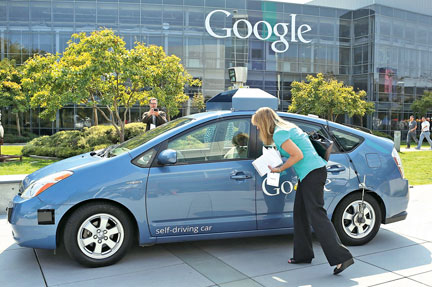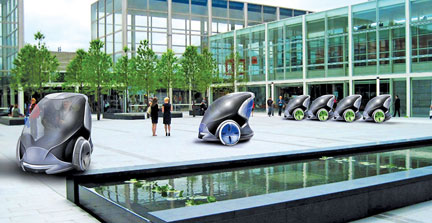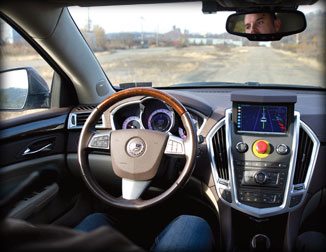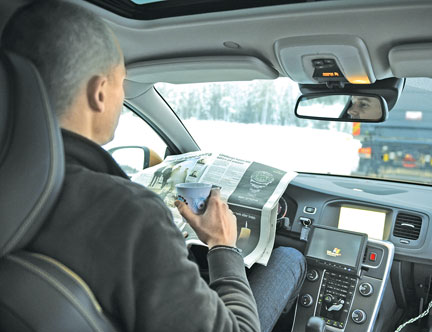Welcome to the fast lane - circa 20 835
By Pramod De Silva
What kind of car will you be driving in the year 2035? Well, chances
are it will drive itself while you read a newspaper on your 2035 version
of the iPad or even on the OLED screen in your car. It will most
probably be electric or powered by hydrogen. It might even fly. It will
communicate with other cars, road signals and the road itself!
 |
|
Driverless cars are
being tested by some leading car-makers |
 |
|
Audi’s concept
‘Connected car’ |
Although this sounds futuristic, all these technologies exist more or
less even now, though they will be far more sophisticated by 2035. But
why focus on 2035? That is when most analysts and auto experts expect
completely driverless cars to take the road.
A glimpse of the future was seen at two events held in the US - the
Consumer Electronics Show (CES) and the Detroit Auto Show. While Google
has been demonstrating driverless tech for years, mainstream car-makers
have now joined the fray.
Technical building blocks
BMW and Audi unveiled their latest driverless car technology and
conducted demonstration drives. BMW added its highly active assist
technology to a modified 2 Series which can slide into a controlled
drift to demonstrate how precise the control systems are and how it can
handle a critical situation. “It’s like the best test driver you have,”
says Dr. Werner Huber, BMW Project Manager.
The car uses steering, braking and throttle to control acceleration,
deceleration and direction in very small, exact amounts. The
demonstration is just one aspect of the technical building blocks
required to make a self-driving car. BMW’s autonomous driving assistant
is also intelligent enough to change lanes to overtake slower vehicles
and then pull back in when the manoeuvre is completed - all without any
prompting or action on the part of the physical (human) driver.
There are also sensors, environmental modelling and decision and
driving strategy technologies that BMW and other car-makers are working
on. The technology is getting smaller and the sensors and cameras are
shrinking to barely noticeable sizes.
Audi demonstrated its Nvidia-powered system, used for key
automated-driving tasks such as traffic sign recognition, lane departure
warnings and pedestrian spotting.
Nvidia also makes 3D displays. For one on-road demo at the CES, Audi
was allowed to tap into the Las Vegas traffic control centre, which
electronically monitors and controls traffic signals across the
metropolitan area. An Audi sedan equipped with an in-car receiver could
drive around town and display what the next traffic light on the road
was about to do.
 |
|
Google has been
demonstrating driverless tech for years |
 |
|
An impression of
driverless cars in Milton Keynes in the UK by 2017 |
Autonomous driving features are at least seven to 10 years away from
becoming commercially available. The technology in the cars is
developing fast, but the main problems are regulations and laws still
mired in the 80s. Laws will have to be updated around the world to make
it legal for automated cars to drive on the road.
As one report put it, “Insurance and liability are particular tricky.
If a car driving itself gets into an accident that results in damages or
injuries, who is responsible? The driver who was watching Netflix on a
state-of-the-art car entertainment system, or the manufacturer that
designed the car?”
Unpredictable human errors
On the other hand, makers of driverless cars say the technology will
be safer than people-driven vehicles because they eliminate
unpredictable human errors such as distracted or drunk driving, or poor
reactions to emergency situations. However, these robotic cars won’t be
completely accident-proof. The first major accident involving the
technology will be a huge public relations hurdle for the entire
industry.
It will most probably be a gradual process. Some cars already have
automated parking features and traffic assistance technology that take
over in specific scenarios. For example, literally at the push of a
button, some versions of the BMW electric i3 will begin the hunt for a
parking spot.
Once found, the driver will be notified on its large colour display
and then, by simply signalling and holding down a button and nothing
else, the car parks. Brake Assist and other emergency assistance
features have been around for a decade or more.
Even in a completely automated car, someone will have to watch the
proceedings and the road ahead. And car engineers need to take into
account the reaction time of the average human confronted with an
emergency-decision making process, which is at least five seconds.
Of course, there is also the question whether those who actually love
to drive cars will fall for highly automated cars. For people who love
the act of driving, taking a powerful car such as a BMW and turning the
action over to an automated system might seem like a waste. For this
reason, all cars are likely to have a manual override.
Privacy will be another big concern. The sensors and in-car systems
can collect data about driving patterns and locations and save that data
in the cloud.
The idea is to use this information to assist the driver, but fears
have been raised that such information could be used by various public
and private organisations in an unethical manner.
 |
|
A driverless car |
 |
|
The car drives itself while the driver
reads the newspaper and enjoys a drink |
Information collection will become more prevalent in the future.
Lines of communications
Eventually, car-makers hope to open the lines of communications
between individual cars on the road to better avoid traffic jams and
prevent accidents. That technology could be even farther off than
automated driving, since car manufacturers need to come together to
agree on protocols and frequencies.
Future cars will even be able to talk to your house. A Mercedes
system lets a car do just that. The interface is with the Nest home
protection system, which can provide remote control of a house’s
thermostat and monitoring of the smoke and carbon-monoxide alarms. A
demonstration showed a car passenger raising the temperature in a
mountain cabin so it would be cosy when the travellers arrived.
Audi also prototyped a tablet-based display system that “lives in
your car” and lets passengers control many vehicle functions. A
demonstration included a back-seat passenger adjusting the cabin
temperature, radio selections and stereo volume.
The tablet can also connect to the Web through a new higher-speed
wi-fi system that is being rolled out in many new Audis this year. The
tablet, which would carry the Audi brand name, is powered by a new
Nvidia Tegra 4 chip. Audi also showed its new laser lights at the CES.
Chevrolet also had an interesting option at the CES that will bring a
near-professional grade performance tracker and recorder into the retail
models of its flagship performance car. The system will allow Corvette
drivers the chance to compare their timings on a race circuit, pull
vehicle information - engine speed and gear selection, brake force, and
steering-wheel angle, to help Corvette owners get the most out of their
new cars.
With all these technologies on offer and undergoing further
development in the years to come, I can hardly wait for 2035. I am sure
most other drivers around the world are also waiting to let go of the
steering wheel, for once. |

